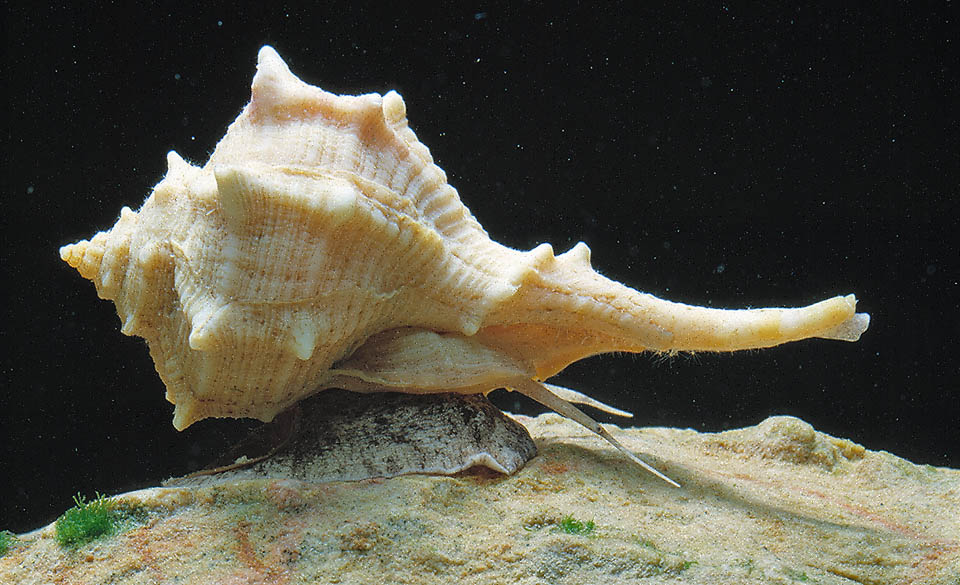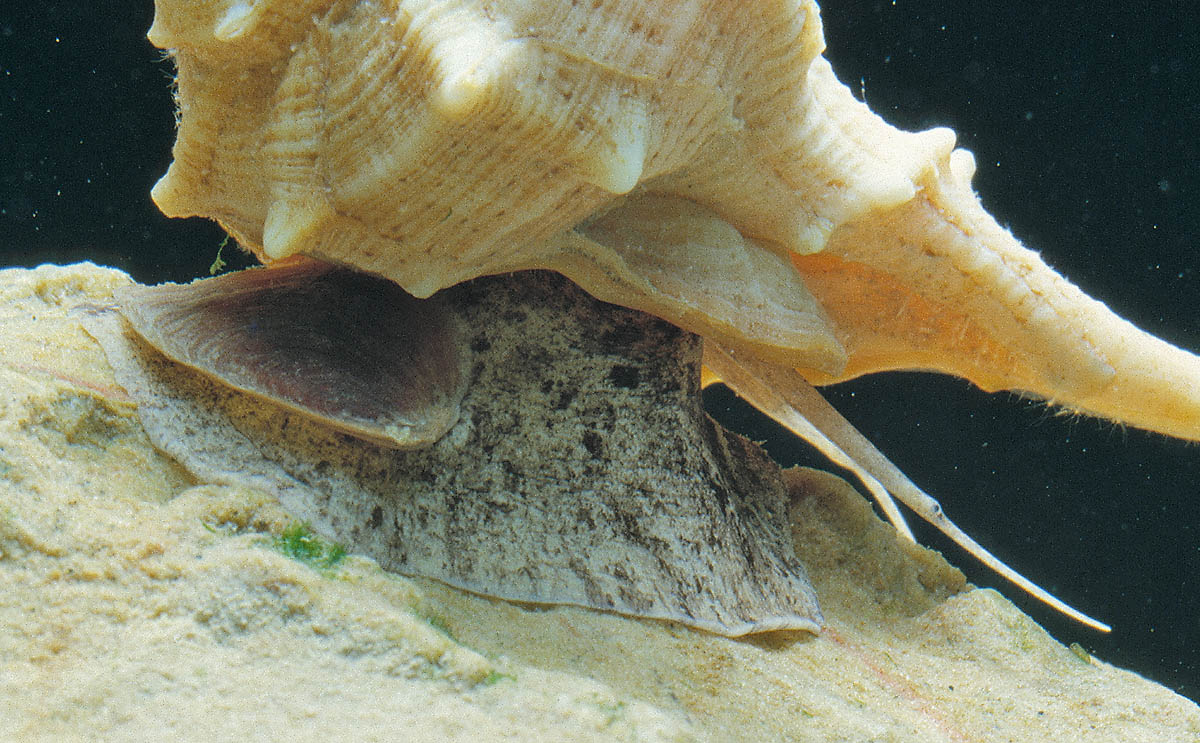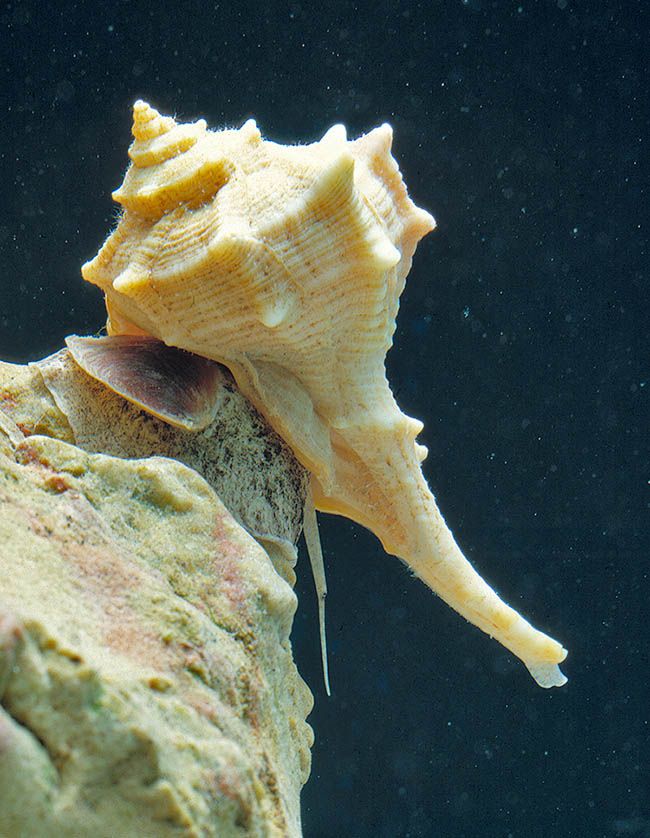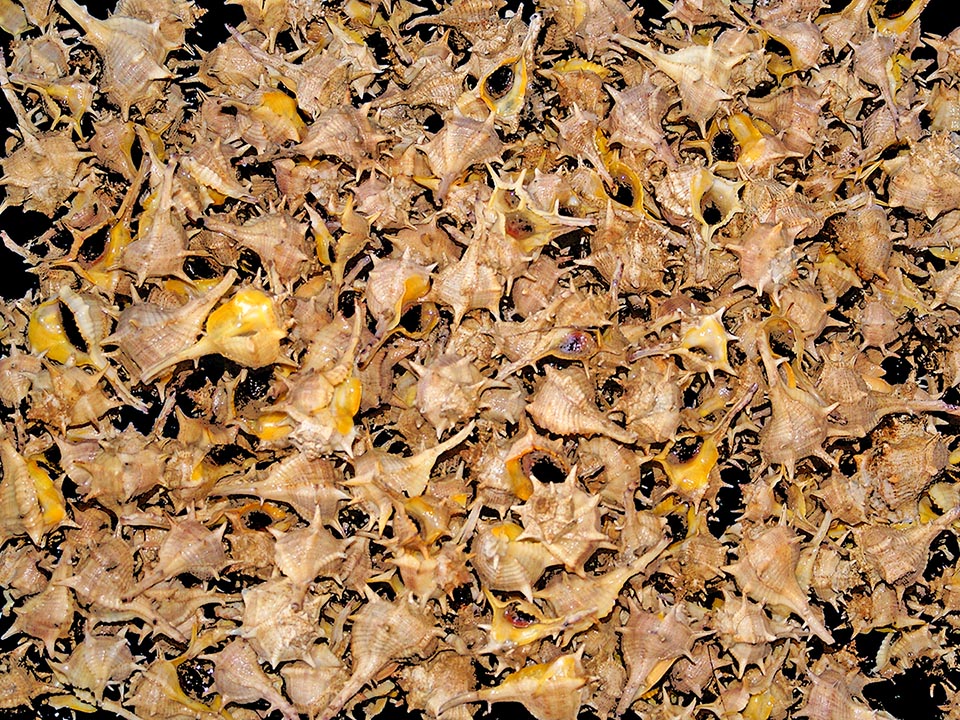Family : Muricidae

Text © Dr Domenico Pacifici

English translation by Mario Beltramini
While walking along the beaches of Lebanon with his dog, the god Melqart remarked that his faithful companion had the snout stained with blood. Worried, he stopped to check its mouth, discovering that the blood covering it was not its own but belonged to a spiny mollusk it held between its jaws. The following morning, Melqart saw that the blood of the mollusk, mixed with the dog saliva had dried and had become of a red colour so bright and bewitching that he decided to create a dress of the same colour for his beloved nymph Tyre. The nymph, once received such a present, decided to marry the god Melqart and in this way was born the so-called “Tyrian purple” that made the fortune of the Phoenician people and that devoted it to history as the “people of the purple”.
Leaving aside the deeds of the god and of the Phoenician people, it is right to concentrate on the animal dead between the jaws of the dog, sacrifice that has caused the origin and the happy ending of this story.
Bolinus brandaris, is a gastropod mollusk belonging to the family Muricidae and together with other specimens of the same family, such as Hexaplex trunculus and, Stramonita haemastoma, represent the the triad of mollusks from where they extracted the compounds for creating the purple.
Commonly known as spiny dye-murex, originally it took the name of Murex brandaris, as the Lain term “murex” may mean “sharp rock” as well as refer to the ammonium salt of the purpuric acid with which the purple was done.

Bolinus brandaris is very common in the Mediterranean and recent studies seem to stress its presence also along the French Atlantic coasts © Giuseppe Mazza
Subsequently the scientific name was changed in Bolinus brandaris by G. Pusch in 1837, where the genus
Bolinus is thought to be coming from the Latin term “bòlus” that means mss, turf, disk, of from the Greek “Βολίνα”, the nymph loved by the god Apollo, or, yet, from the Greek “βολις”, bolide, probe, highly luminous meteor.
Also the name of the species brandaris has a confused origin and is not well known, and it is thought that it can be referred to the term “brandire” of Germanic origin from the term “Brand”, club or sword. Perhaps alluding to the spines characterizing this muricid or to the siphonal canal so long to represent a “club to brandish”.
Zoogeography
Bolinus brandaris is a species very common in the Mediterranean Sea in practically all coasts: from the Strait of Gibraltar to the coasts of Lebanon and of Turkey. Recent studies seem to evidence the passage through Gibraltar Strait to go as far as the Atlantic Ocean reaching the northern coasts of France. These data, however, are still being analyzed. In such areas it is reasonable to think that it has been introduced as an alien species through the involuntary transportation of larvae and/or young specimens.

Detail of the big foot with the operculum. To obtain information from the environment it turns out two tentacles, called rhinophores, with sensitive and tactile function © Giuseppe Mazza
Ecology-Habitat
This muricid loves sandy or muddy seabeds, where it sinks almost completely at a depth varying from 5 to 50 m, even if specimens have been at almost 200 m of depth thus showing a great bathymetric variability. Rarely, moreover, it is possible to find it on shallow rocky bottoms.
Bolinus brandaris is a greedy predator of other mollusks, also able to eat coelenterates and echinoderms. It is particularly fond of mussels, which it eats by forcing the opening of the valves with its powerful foot or piercing their shell with the help of the radula, a sort of rasping tongue characteristic of this phylum and that differs in shape and function among the species. It integrates a more generalist diet acting as a seabed cleaner and eating the carcasses of other animals it finds around.
Morphophysiology
Bolinus brandaris displays a marked polymorphism and the number of morphotypes is unbelievably high, so much that even Linnaeus describes three different forms in his studies.

The spirally conformed roundish shell can reach 8-10 cm of length © Giuseppe Mazza
To complicate the situation there is also an ample degree of individuals defined as anomalous that opens the doors to another branch of study defined “Teratology” where the morphological anomalies of an entire organism or of one or more parts of it are analyzed.
This leads to having specimens with very marked structural modifications and having, for instance, three siphonal canals, an outer lip completely deformed or a glaringly deformed spiralization. These anomalies may interest the soft parts of the animal as well as the shell and may come from genetic origins or accidental causes such as predation or parasitic infections. In this scenario, for the sake of simplicity, we shall consider the specimen better described and better known also on a historical level coming from the Italian shores.
The shell of Bolinus brandaris presents roundish with a spiral conformation and a colour varying from yellow to brown and can reach the length of 8-10 cm. The spiral is composed of six coils each one carrying 4 to 8 spines, usually more marked in the juvenile specimens, arranged in one only line and increasing in shape as they get closer to the operculum.
The shell is not uniform because during the growth phase of the animal there is alternation between growth phases with resting ones, where they will form the spines that thicken the edge of the shell. The globular part of the shell extends in a siphonal canal extensive and well pronounced, characteristic that renders it very distinguishable and that, as previously said, gives the name to this species.
The operculum is particularly big, with thick and robust outer lip, able to host an equally important foot capable to close perfectly the opening when the mollusk retreats to defend itself from the predators.
The shell is often covered by epibionts, small organisms like green and calcareous algae living on the surface of the hosting organism, capable of masking the brownish colour and rendering the shell more camouflaged with the environment.
The mollusk is of brown colour with a foot of the same colour but characterized by a speckled drawing. To collect information from the environment it everts white tentacles having a sensitive or tactile function called rhinophores.
The famous purple originates from a particular hypobranchial gland present in the pallial cavity. It produces a colourless liquid that, after appropriate maceration and exposition in contact with light, passes through different colour stages to reach the purplish violet.
Ethology-Reproductive Biology
This species has two reproductive seasons: in March-April and during the months of June-July.

Bolinus brandaris is now fished only for food purposes but once it gave also a precious dye for fabrics, the purple, a red with particular violet shades © Hans Hillewaert
The sexes are very distinct but there is no sexual dimorphism; therefore, male and female specimens have the same size. Moreover, the females display a peculiar characteristic, that is a non-functioning rudimentary penis.
Some studies have evidenced how there exists a substantial asynchrony between the sexes for what concerns the maturation of the gametes, in particular the existence of mature males when the females were not so. It is thought that this phenomenon increases reproductive success as it allows the females to lay eggs only when the environmental conditions are favourable to the production and survival of the ovules.
The eggs are laid in a way to form a sort of spongy ball about 80 cm big. This methodology and form is similar, if not equal, to that of the alike species Hexaplex trunculus rendering difficult an identification in absence of adults close to the laid eggs.
After the development, takes form a larva typical to the gastropods called able to swim thanks to a powerful organ: the velum, formed by small cilia fundamental for nutrition and locomotion of the animal.

For instance, we find it in the splendid furnitures of the “Salon violet” in the Chantilly Château Museum © Musée Condé Chantilly
Bolinus brandaris has been and still is one of the most known and important mollusks of the history, also cultural, of human civilization. It is an edible species and for centuries has been fished also for the sustenance as well as for the purple, which already needed high quantities of specimens.
In modern times the fishing is ruled by stringent rules that forbid the catching during the periods of reproduction and the species does not result as at risk of extinction. The globalization and the borders now demolished between the nations for the commercial exchanges have opened the doors to another problem having the same size: the introduction of alien species. The studies and the preventions are carried out more in this context as Bolinus
brandaris is, as said, a voracious predator and would risk to put in serious danger the endemic species of the environment where it is introduced.
Synonyms
Murex brandaris Linnaeus, 1758; Purpura fuliginosa Röding, 1798; Murex tuberculatus Roding, 1798; Murex pseudobrandaris Grateloup, 1833; Murex subbrandaris d’Orbigny, 1851; Murex trifariaspinosus Frauenfeld, 1869; Murex trispinosus Locard, 1886; Murex monospinosus Serradell, 1912; Murex tudiculoides Coen, 1943; Murex pseudobrandaris zanardii Settepassi, 1970.
→ To appreciate the biodiversity within the MOLLUSCS please click here.
